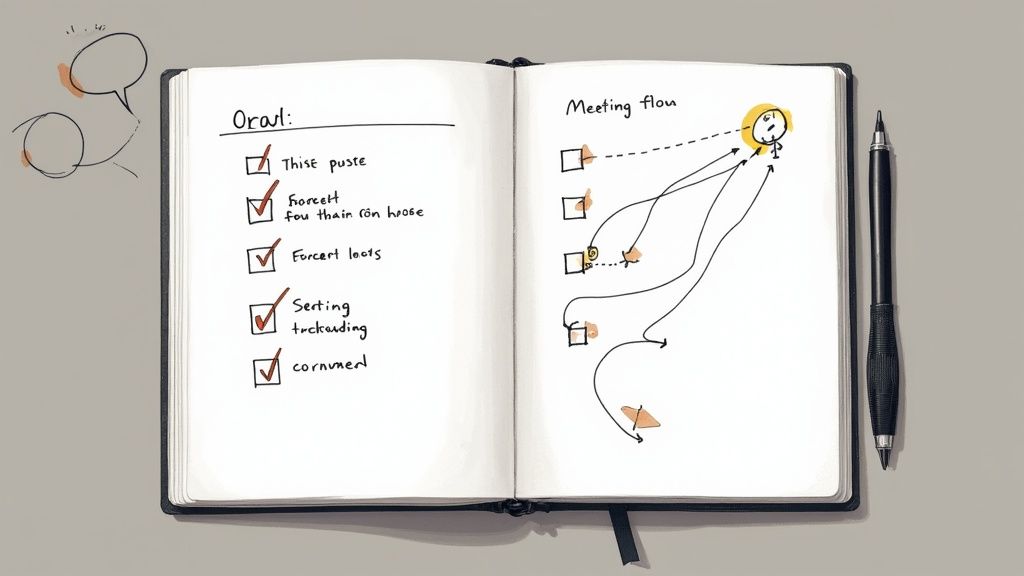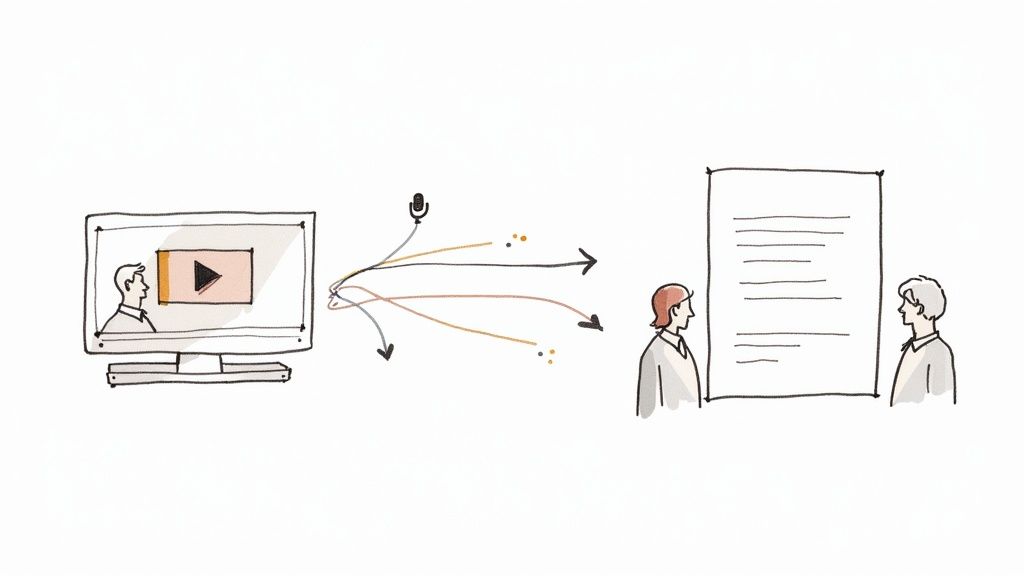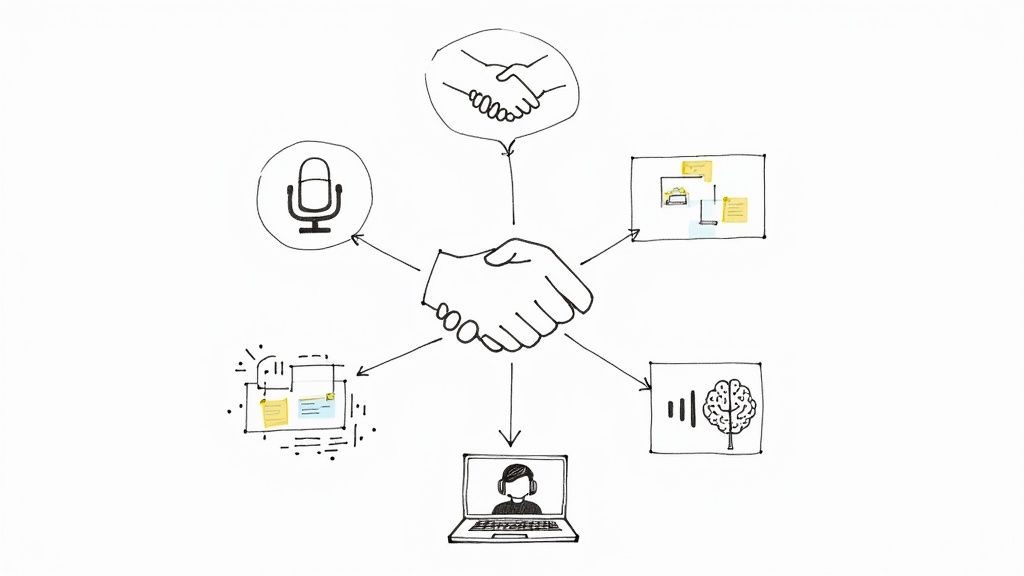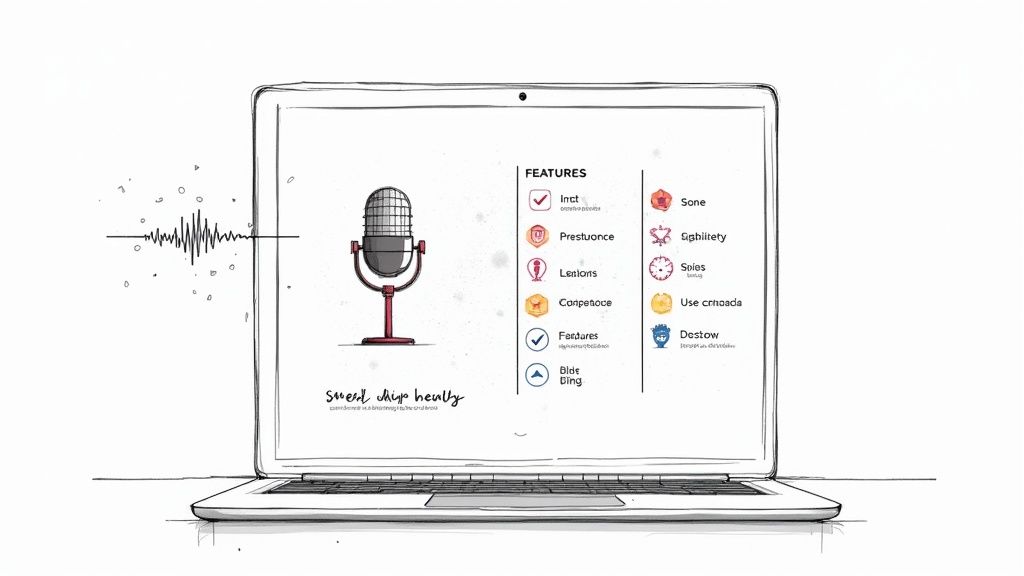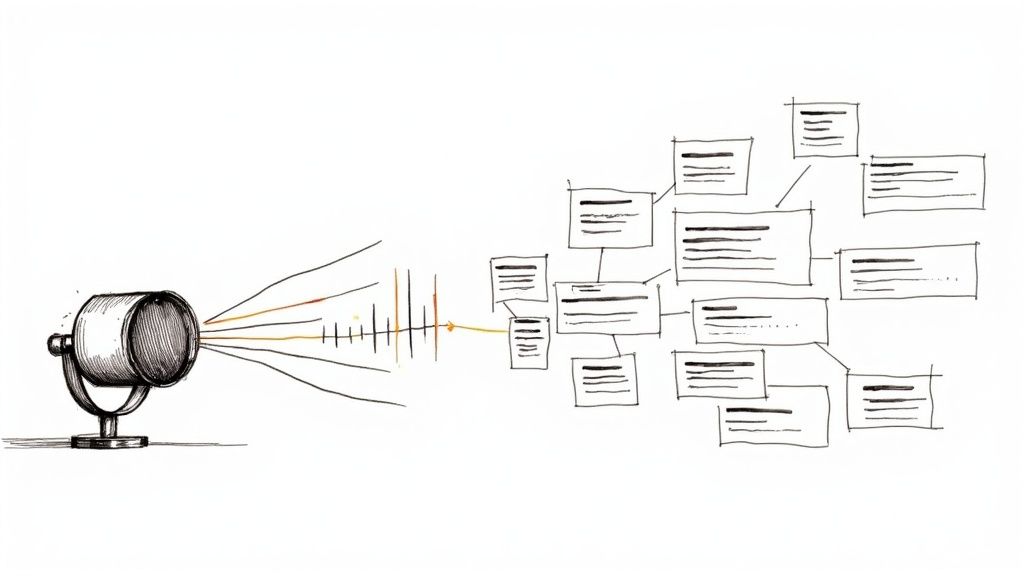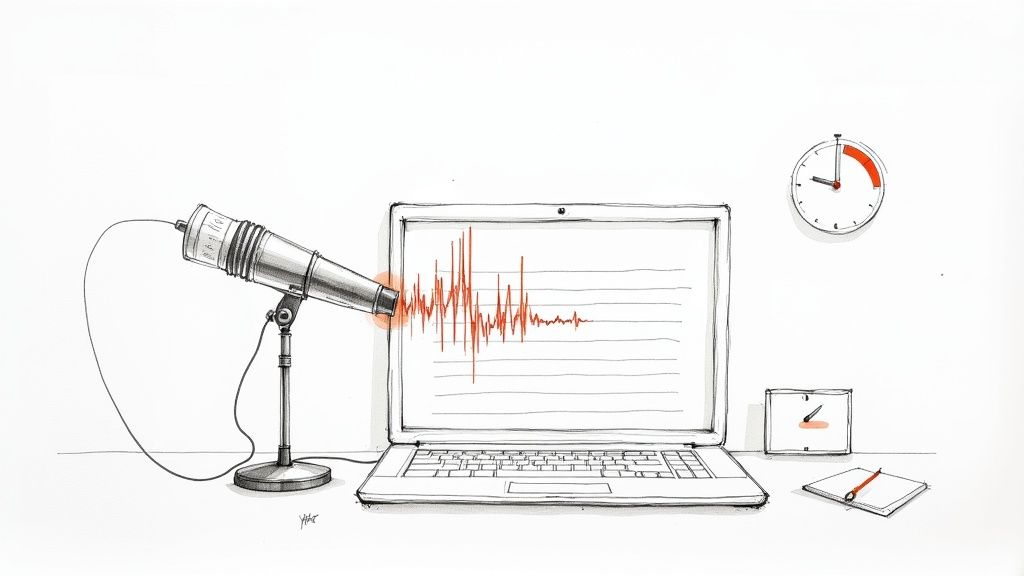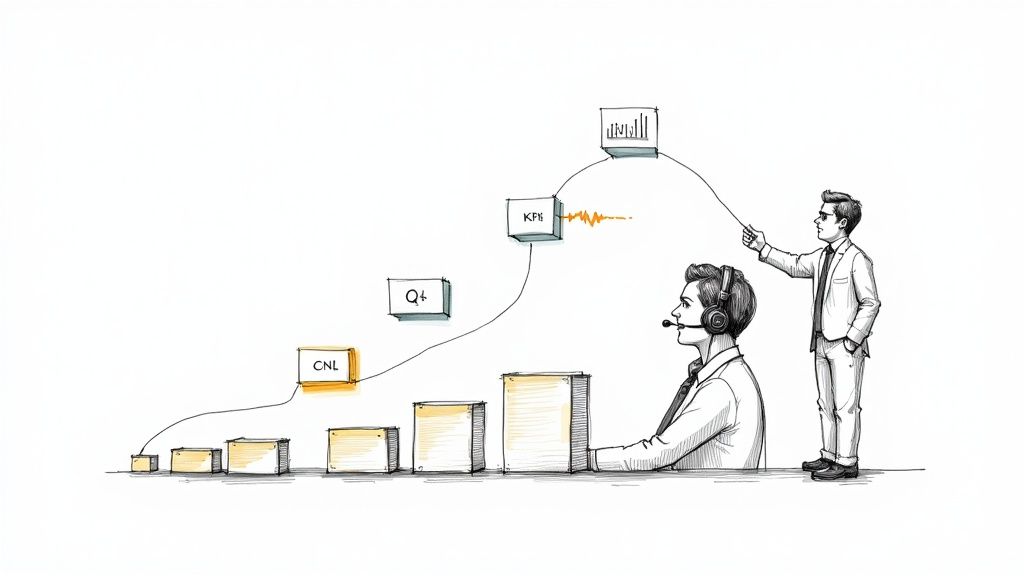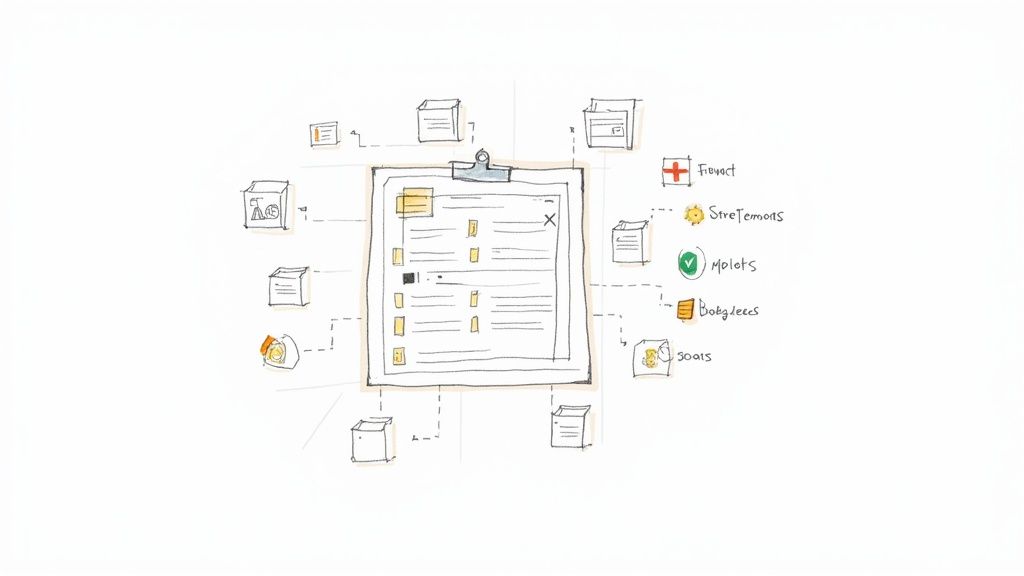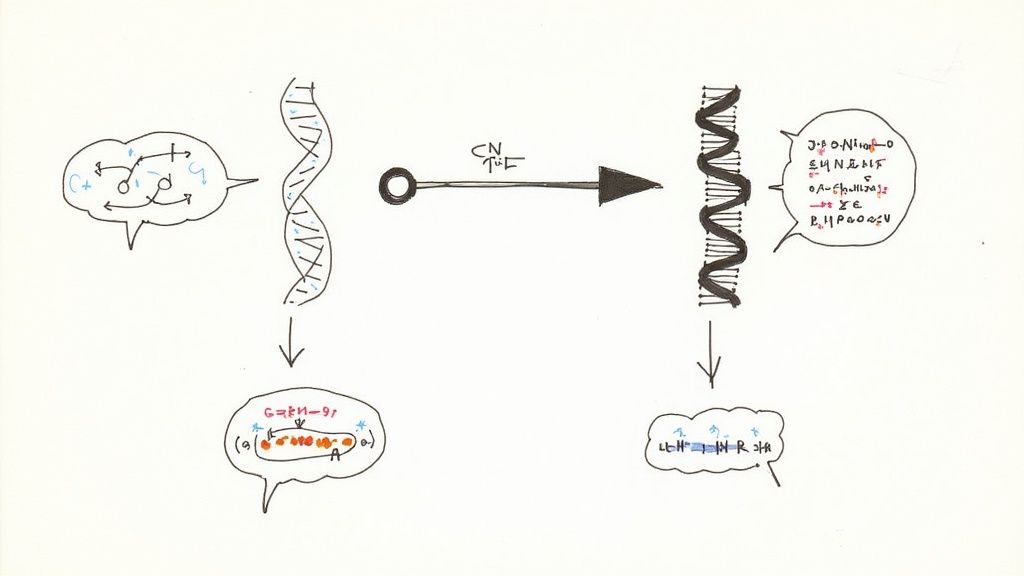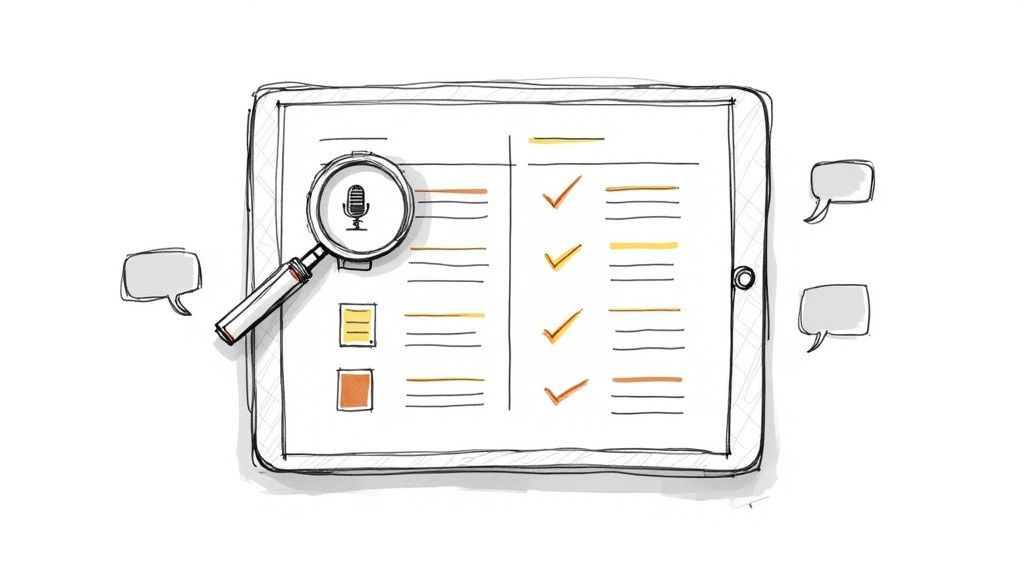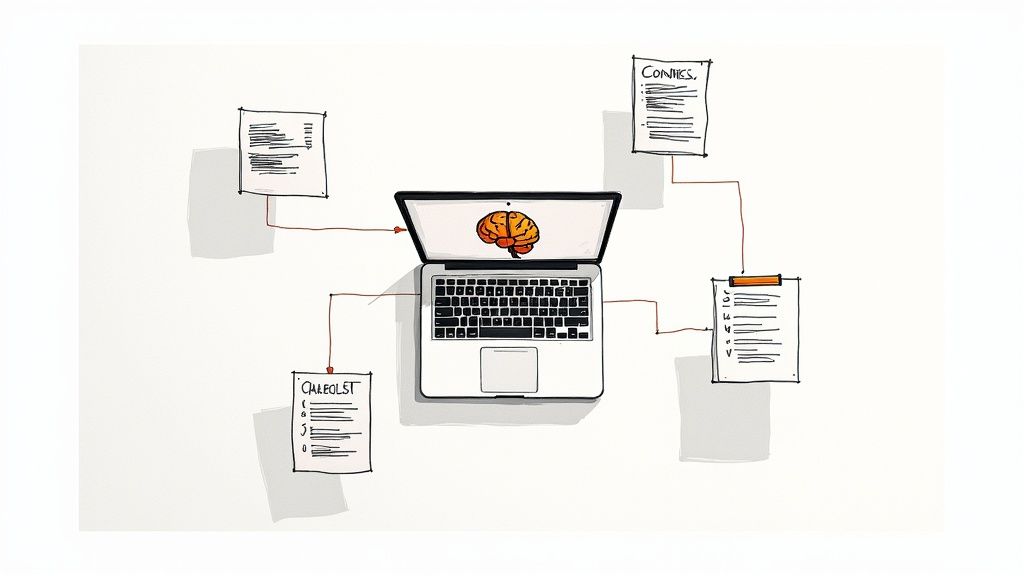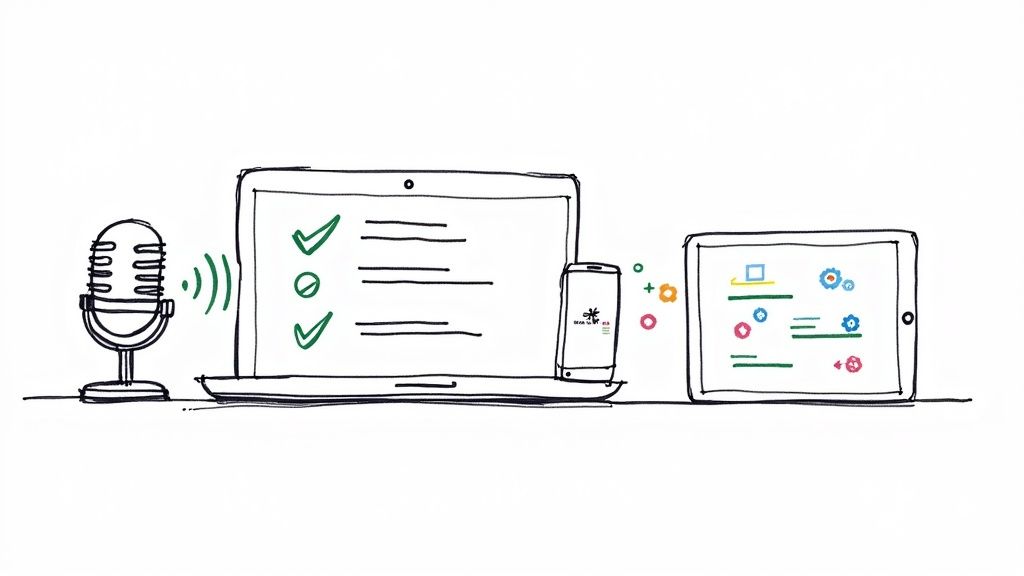What Is Conversation Intelligence? A Practical Guide
Conversation intelligence uses powerful AI to capture, transcribe, and analyze your customer conversations. By transforming spoken words into structured data, it gives sales, support, and marketing teams the clear, actionable insights they need to perform better.
Think of it this way: if your business is a sports team, every customer call is a game. In the past, you could only review a few highlight reels and would miss most of the critical plays. My own experience has shown that conversation intelligence acts like a full-time coaching staff, dissecting every single play so you understand exactly what leads to a win—and what causes a loss.
What Exactly Is Conversation Intelligence?
Instead of just recording calls for later playback, this technology provides a much deeper analysis of each dialogue. From my experience helping teams implement these tools, I've seen firsthand that it's not just about tracking words; it's about understanding tone, context, and intent. In short, it reveals how conversations actually unfold and why they directly impact your business outcomes.
Turning Unstructured Talk into Actionable Data
At its core, conversation intelligence is the process of converting messy, unstructured dialogue into clear, structured insights. It helps you answer critical business questions that once relied on guesswork:
- What are the most common objections we hear during product demos?
- Which competitor gets mentioned most often when we're negotiating price?
- Do my top-performing reps spend more time talking or listening?
- Is there growing frustration around a new feature we just launched?
Getting clear answers to these questions allows teams to shift from making decisions based on anecdotes to relying on solid data. It’s a significant change, and industry trends reflect this: by 2025, it's predicted that 76% of companies will use this technology in over half of their customer interactions.
Conversation intelligence isn’t about micromanaging your team—it’s about empowering them. It delivers the honest, data-backed feedback needed to refine sales pitches, improve support, and consistently win more business.
This creates a ripple effect of benefits across the organization. Marketing can sharpen its messaging based on real customer language. Product managers can spot unmet needs. Support leaders can identify and address rising issues before they escalate. The end result is a unified, accurate view of your customers' true voice.
Conversation Intelligence at a Glance
Here’s a simple table breaking down the core components of conversation intelligence. I find this helps teams quickly understand what each part does and the primary benefit it brings.
Use this snapshot to help get your stakeholders aligned on what conversation intelligence is and why each layer is so important for driving real business results.
How Does Conversation Intelligence Technology Actually Work?
Ever wondered what’s happening "under the hood" of a conversation intelligence platform? It's a sophisticated process that takes raw, unstructured audio from your calls and meetings and, step-by-step, refines it into something incredibly valuable: structured data you can use to make smarter business decisions.
This entire process is powered by advanced AI. It's a key part of the conversational AI market, which was valued at USD 12.24 billion in 2024 and is projected to grow to nearly USD 61.69 billion by 2032. The reason for this explosive growth is simple: businesses are finally realizing how much value is hidden within their everyday conversations.
This image provides a great overview of the journey from a simple conversation to a powerful business insight.
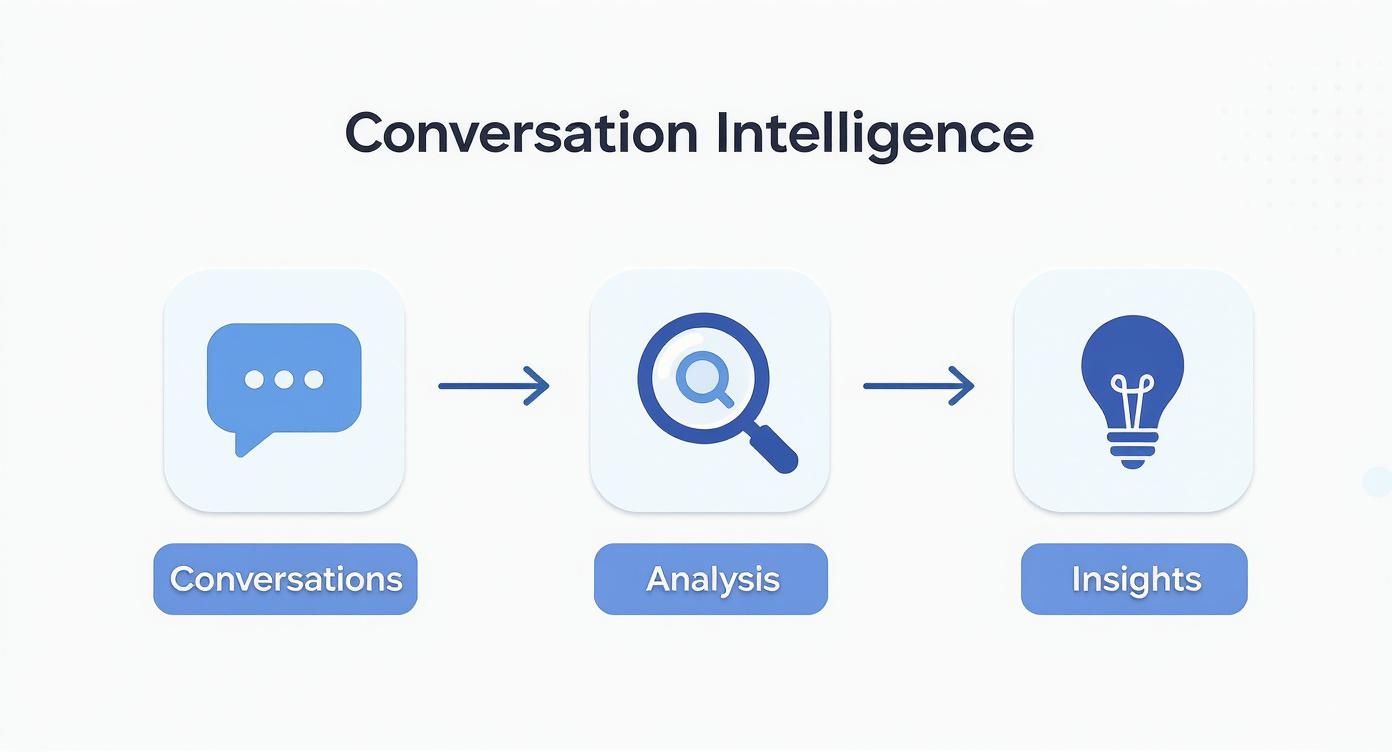
As you can see, it’s a three-part flow: capturing the conversation, analyzing what was said, and then delivering insights that help you drive your business forward. Let's break down each step.
Step 1: Speech-to-Text Transcription
The first and most fundamental step is turning spoken words into written text. This is handled by Automatic Speech Recognition (ASR) technology.
Imagine a stenographer who can listen to any Zoom call, Microsoft Teams meeting, or phone conversation and flawlessly type out every word spoken. That’s essentially what ASR does. This is the foundational layer—if the transcription is inaccurate, all the analysis that follows will be flawed.
Fortunately, modern ASR technology is incredibly accurate. It can handle various accents, differentiate between speakers, and produce a reliable transcript. For those interested in a deeper dive, our guide on auto transcribe software offers more detail on this specific technology.
Step 2: Making Sense of the Words with NLP
Once you have the text transcript, the real "intelligence" begins. This is where Natural Language Processing (NLP) comes into play. If ASR tells you what was said, NLP helps you understand so what? by deciphering the meaning behind the words.
NLP is the analytical brain of the platform. It reads the text and starts to connect the dots, understanding the context, emotion, and the speaker's true intent.
Here are a few key tasks NLP performs:
- Topic Detection: It identifies what the conversation is about, automatically tagging moments when keywords like "pricing," "contract terms," or a competitor's name are mentioned.
- Intent Analysis: It goes a step further to understand why something was said. Was that a question? A complaint? A clear buying signal?
- Sentiment Analysis: NLP also picks up on the emotional tone. It can flag moments when a customer is becoming frustrated, even if they don't explicitly say "I'm angry."
Here’s a simple analogy I like to use: ASR gives you the script of a movie. NLP is the director who understands the actors' motivations, the subtext in their lines, and the overall emotional arc of the story.
Step 3: From Data Points to Actionable Insights
The final step is where the platform connects all the dots. It aggregates the analyzed data from hundreds—or even thousands—of conversations and begins to spot patterns and trends. To better understand how machines process these interactions, it's helpful to see how similar AI principles work in other applications, as explained in this article on How Do AI Chatbots Work: Unveiling The Mechanics Behind Intelligent Conversations.
This is where individual call notes are transformed into a strategic business asset. You can see which sales pitches are most effective, what product features customers are asking for, or where your support team might need additional training. This is how raw conversation becomes true business intelligence.
Unlocking Key Features And Metrics
Understanding what is conversation intelligence is about more than just technology; it’s about turning every customer interaction into a source of insight your team can use.
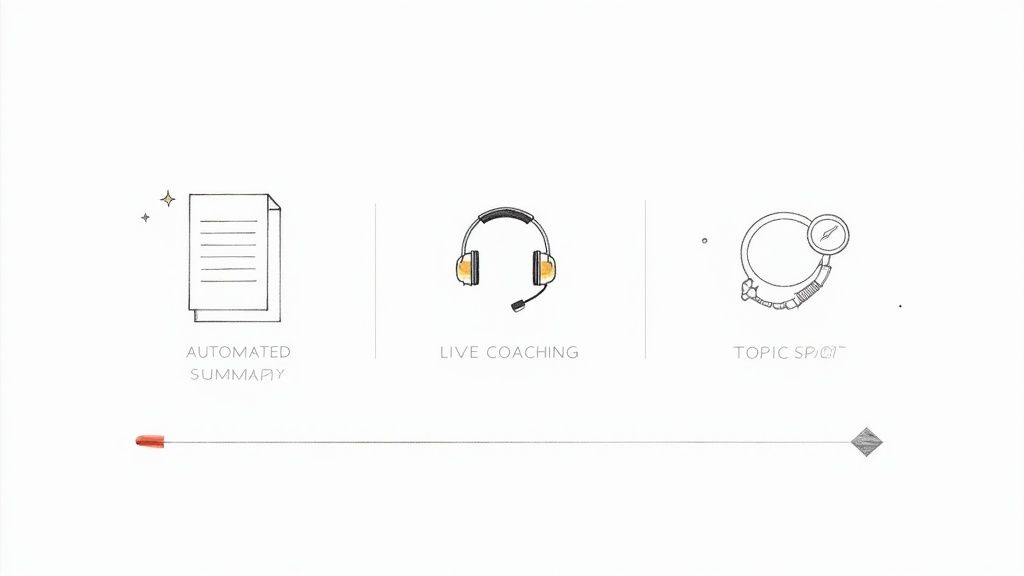
From my experience, it’s like having an analytical co-pilot on every call. It doesn’t just record—it flags key moments, summarizes long discussions, and helps guide your team toward the right next steps.
Core Features That Drive Performance
The best conversation intelligence platforms offer features designed to solve real business challenges, freeing up your team to focus on what matters most: the customer.
- Automated Call Summaries: This feature produces concise recaps, highlighting key takeaways and action items without any manual note-taking. This ensures follow-up tasks are never missed.
- Real-Time Agent Coaching: When a competitor is mentioned or a tough objection arises, this delivers on-screen prompts to the representative, providing them with the right talking points or content at the exact moment they need it.
- Topic And Keyword Spotting: This automatically tags conversations with relevant themes like "pricing," "contract terms," or specific product names. You can then instantly search your call library for trends or coaching examples.
A single insight from one call can become a valuable learning moment for your entire team, and potential issues can be flagged and addressed before they snowball.
Key Metrics That Actually Matter
Data is only valuable when it guides action. The right metrics provide a clear window into performance, customer sentiment, and areas for improvement.
A talk-to-listen ratio, for example, reveals who is controlling the conversation. If I see that a sales rep is dominating the dialogue, it’s a clear signal that I need to coach them on active listening skills.
Tracking question rates helps uncover engagement levels. A high number of questions from a prospect usually indicates strong interest, while a silent line might signal confusion or disinterest.
Essential Conversation Intelligence Features vs. Business Impact
Before choosing a platform, it's crucial to map its features to clear business outcomes. Here’s a quick comparison I use to help teams evaluate their options:
By focusing on these features and metrics, you can equip your team to coach more effectively, close more deals, and keep a finger on the pulse of customer sentiment.
Real-World Use Cases For Your Business
Theory is one thing, but seeing how conversation intelligence actually works in practice is where its value becomes clear. This isn't just about a dashboard full of charts; it's a practical toolkit that different departments can use to solve real-world problems and achieve their goals.

From the sales floor to the support queue, I've seen teams turn everyday talk into a significant strategic advantage. Let's walk through a few powerful examples of how you can put this to work.
Supercharge Your Sales Team
Every sales leader I've ever worked with asks the same fundamental question: "What makes my top performer so good, and how can I replicate that success?" Conversation intelligence finally provides the answer by analyzing their calls and pinpointing exactly what they do differently.
For instance, a sales manager might have a hunch that their star rep closes more deals after mentioning a specific case study. The platform can scan hundreds of calls and confirm that pattern in minutes.
Armed with this data, the manager can take immediate, effective action:
- Create targeted coaching: They can build training sessions around that specific talk track, showing other reps how and when to use it.
- Update sales playbooks: The winning script can be added to the official playbook as the new best practice for handling a certain objection.
- Onboard new hires faster: New reps can be given a proven formula for success from day one, dramatically reducing their ramp-up time.
Suddenly, anecdotal success is no longer a mystery. It becomes a repeatable, scalable strategy that can be rolled out to the entire team.
Empower Customer Support and Success
For support teams, conversation intelligence acts as an early-warning system. It helps managers identify and address brewing issues long before they escalate into widespread customer complaints.
Imagine a support manager notices a sudden spike in calls where customers mention the phrase "login error." The platform flags this trend automatically.
By analyzing the sentiment and context of those calls, the manager realizes that a recent software update is causing the issue, but only for a specific group of users. They can alert the product team immediately with hard data, preventing a major incident and saving countless customers from frustration.
This proactive approach to call center quality assurance is a complete game-changer. It transforms support from a reactive cost center into a strategic partner that actively improves the customer experience. When you can pinpoint root causes from actual conversations, you don’t just resolve tickets—you build loyalty.
Sharpen Your Marketing Messaging
Marketers are constantly striving to capture the "voice of the customer." Conversation intelligence delivers it directly to them by analyzing the exact words and phrases customers use when discussing their challenges and goals.
Let's say a marketing team is planning a new campaign. They can use the platform to search for recurring questions about a key product feature. They might quickly discover that prospects frequently ask, "How does this integrate with our existing workflow?"
This single insight can become the foundation of their entire creative strategy:
- Ad Copy: They can create ads with headlines that directly address this concern, like, "Seamless Workflow Integration for Teams Like Yours."
- Landing Pages: The campaign's landing page can feature a prominent section that walks visitors through the simple integration process.
- Content: The content team can produce a detailed guide or video tutorial that specifically answers this common question.
This ensures the marketing messages resonate on a deeper level because they are built from real customer language, not just internal assumptions. It's no surprise that the conversation intelligence software market is projected to reach USD 57.87 billion by 2034, a significant jump from USD 23.14 billion in 2024. This growth is a testament to the tangible value it delivers.
How to Choose and Implement The Right Platform
Once you're ready to bring conversation intelligence into your workflow, the key is to choose a tool that solves your specific problems and delivers a clear, measurable return on investment.
In my experience, a successful rollout begins long before you sign a contract. It starts with a clear vision of what you want to achieve. Without specific goals, even the most advanced technology can fail to deliver results.
Define Your Goals Before You Shop
Before you even start looking at vendor websites, sit down with your team and define what success will look like. Vague goals like "improve sales" are not helpful. You need to focus on specific, measurable outcomes that the technology can directly influence.
Your goals should be concrete, like these examples:
- Reduce new sales hire ramp-up time by 30% by building a library of our best call recordings for training.
- Increase qualified opportunities by 20% by identifying the talk tracks our top performers use and scaling them across the team.
- Improve customer satisfaction scores by 15% by automatically flagging calls with negative sentiment for manager review.
When you have these targets established, you have a powerful framework for evaluating different platforms. You can cut through the marketing jargon and ask vendors to show you exactly how their tool will help you achieve your specific goals.
Your Vendor Evaluation Checklist
Once your goals are set, it’s time to evaluate potential partners. This process should go beyond a simple feature comparison. Think of it more like hiring a key employee—you need to ensure they are reliable, secure, and easy to work with.
When meeting with vendors, come prepared with these essential questions:
- Integration and Workflow: How smoothly does the platform connect with our CRM and communication tools? Will it genuinely automate tasks like data entry and call summaries?
- Transcription Accuracy: What is the real-world accuracy rate, especially with our industry-specific jargon or regional accents? Ask for a demo using your own call recordings to verify.
- Ease of Use: How intuitive is the platform for our reps and managers? What does the onboarding and training process involve? Be realistic about your team’s technical skills.
- Security and Compliance: How and where is our conversation data stored and encrypted? Does the platform meet our industry's compliance standards (like HIPAA or GDPR)?
Choosing a platform is about finding a strategic partner. The right tool should feel like a natural extension of your team, not just another piece of software they are forced to learn. A great solution simplifies workflows, acting as an effective AI meeting note taker and freeing up your people to focus on the conversation itself.
Answering Common Questions About Conversation Intelligence
Whenever a powerful new technology emerges, a lot of questions come with it. That’s a good sign—it means you're thinking critically about how it fits into your business. Let's tackle some of the most common questions teams have when they first explore conversation intelligence.
What’s The Difference Between Conversation Intelligence And Speech Analytics?
This is probably the most frequent question I get, and it's a critical distinction to understand. The simplest way I explain it is this: speech analytics gives you the raw transcript, but conversation intelligence tells you the story behind the transcript.
Speech Analytics is primarily focused on the what. Its main function is to convert spoken words into text. It's useful for basic keyword spotting and compliance checks, essentially creating a searchable log of what was said.
Conversation Intelligence digs into the how and the why. It doesn’t just process words; it understands context, tone, sentiment, and even conversational dynamics like the talk-to-listen ratio. It's designed to extract strategic insights that you can use for coaching, forecasting, and making smarter business decisions.
So, while speech analytics provides the script, conversation intelligence helps you understand the actors' motivations, the plot twists, and the final outcome of the story.
Is This Just A Tool For Big Enterprise Sales Teams?
Absolutely not. While it's true that conversation intelligence first gained traction in enterprise sales, its value is now being recognized across entire organizations of all sizes.
Any team that communicates with customers can benefit significantly from this technology:
- Customer Support can use it to identify recurring product bugs or common points of friction before they become major issues.
- Marketing can listen to how customers actually describe their needs and use that exact language in new campaigns for better resonance.
- Product Teams can get unfiltered feedback, hearing feature requests and frustrations directly from the user's mouth.
If your team interacts with customers, there are valuable insights hidden in those conversations waiting to be discovered.
How Accurate Is The Transcription And Analysis, Really?
The accuracy has improved dramatically in recent years. Top-tier platforms now regularly achieve 90-95% transcription accuracy, especially with clear audio quality. This level of reliability is the essential foundation for all the analysis that follows.
The AI-driven insights are also becoming more sophisticated all the time.
But here’s the real power of conversation intelligence: it's not just about getting one call perfectly right. It's about identifying the patterns and trends across hundreds or even thousands of calls—insights that no human could ever detect on their own. That's where the most reliable and game-changing discoveries are made.
Ready to turn your team's conversations into your biggest competitive advantage? HypeScribe provides the AI-powered transcription and analysis you need to uncover actionable insights, coach your team effectively, and drive business growth. Start your free trial today and see what your conversations are really telling you.



